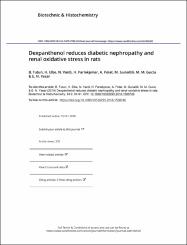| dc.contributor.author | Tutun, B. | |
| dc.contributor.author | Elbe, Hülya | |
| dc.contributor.author | Vardı, N. | |
| dc.contributor.author | Parlakpınar, H. | |
| dc.contributor.author | Polat, A. | |
| dc.contributor.author | Günaltılı, M. | |
| dc.contributor.author | Yaşar, E. N. | |
| dc.date.accessioned | 2020-11-20T14:42:37Z | |
| dc.date.available | 2020-11-20T14:42:37Z | |
| dc.date.issued | 2019 | |
| dc.identifier.issn | 1052-0295 | |
| dc.identifier.issn | 1473-7760 | |
| dc.identifier.uri | https://doi.org/10.1080/10520295.2018.1508746 | |
| dc.identifier.uri | https://hdl.handle.net/20.500.12809/1091 | |
| dc.description | Parlakpinar, Hakan/0000-0001-9497-3468; Tutun, Bugra/0000-0002-3803-0489 | en_US |
| dc.description | WOS: 000467970800001 | en_US |
| dc.description | PubMed ID: 30317873 | en_US |
| dc.description.abstract | Hyperglycemia increases reactive oxygen species (ROS) and the resulting oxidative stress contributes to the development of diabetic complications. Dexpanthenol (Dxp) is the biological active form of pantothenic acid. We investigated whether Dxp administration could decrease oxidative stress as a way to treat renal complications of diabetes mellitus (DM). Thirty-two male Wistar albino rats were divided into four groups: control, Dxp, DM and DM + Dxp. Experimental diabetes was induced by a single dose of streptozotocin (STZ). After administration of STZ, the DM + Dxp group was administered 500 mg/kg Dxp intraperitoneally every day for 6 weeks. At the end of the study, blood glucose levels were measured and rats were sacrificed. Kidneys were embedded in paraffin, sectioned and stained with hematoxylin and eosin, and periodic acid-Schiff. The mean malondialdehyde levels, glutathione peroxidase, superoxide dismutase and catalase activities, and total antioxidant and total oxidant status also were measured. The control group was normal in histological appearance. We observed congestion, inflammation, glomerulosclerosis, tubular desquamation, loss of villi and hydropic degeneration in tubule cells in the DM group. Indicators of oxidative stress were elevated and antioxidant activity was reduced in the DM group compared to controls. In the DM + Dxp group, oxidative stress was decreased, antioxidant activity was increased and histopathological changes were reduced compared to the DM group. We found that Dxp exhibited ameliorative effects on STZ induced diabetic nephropathy by increasing antioxidant activity. | en_US |
| dc.description.sponsorship | Turkish Scientific and Technological Research Council (TUBITAK) under Domestic University Students Research Projects Support Programme [2209-A/2012] | en_US |
| dc.description.sponsorship | Our project was supported by Turkish Scientific and Technological Research Council (TUBITAK) under Domestic University Students Research Projects Support Programme, 2209-A/2012. | en_US |
| dc.item-language.iso | eng | en_US |
| dc.publisher | Taylor & Francis Ltd | en_US |
| dc.item-rights | info:eu-repo/semantics/openAccess | en_US |
| dc.subject | Dexpanthenol | en_US |
| dc.subject | Diabetes | en_US |
| dc.subject | Nephropathy | en_US |
| dc.subject | Oxidative Stress | en_US |
| dc.subject | Rat | en_US |
| dc.title | Dexpanthenol reduces diabetic nephropathy and renal oxidative stress in rats | en_US |
| dc.item-type | article | en_US |
| dc.contributor.department | MÜ, Tıp Fakültesi, Temel Tıp Bilimleri Bölümü | en_US |
| dc.contributor.institutionauthor | Elbe, Hülya | |
| dc.identifier.doi | 10.1080/10520295.2018.1508746 | |
| dc.identifier.volume | 94 | en_US |
| dc.identifier.issue | 2 | en_US |
| dc.identifier.startpage | 84 | en_US |
| dc.identifier.endpage | 91 | en_US |
| dc.relation.journal | Biotechnic & Histochemistry | en_US |
| dc.relation.publicationcategory | Makale - Uluslararası Hakemli Dergi - Kurum Öğretim Elemanı | en_US |


















